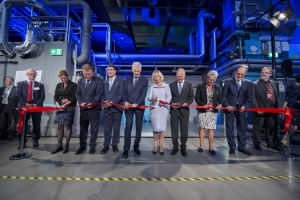European XFEL inaugurated
04-09-2017
European XFEL free electron laser built in Hamburg was inaugurated on September 1, 2017. The ceremony was attended by numerous officials, including Professor Łukasz Szumowski, Polish Deputy Minister Science and Higher Education, and Professor Krzysztof Kurek, NCBJ Director General. The laser has brought about quite new experimental opportunities to physicists, chemists, biologists, and engineers all over the world. NCBJ co-owns the facility.
In his speech given at the ceremony Minister Szumowski pointed out that the XFEL project was among just a few examples of projects to develop a research infrastructure that had been accomplished in time at costs not exceeding the planned budget. Zbigniew Gołębiewski, NCBJ Deputy Director for Economy informed that management of the European XFEL GmbH company had officially confirmed that all obligations of NCBJ (and generally of Poland) to deliver in-kind contribution to European XFEL laser had been dully fulfilled. NCBJ, a partner in the company, intends to contribute to the facility running costs. Currently the key challenge for Polish researchers is to submit valuable proposals of experiments which might be run in Hamburg by them.
Briefly about European XFEL (excerpts from the Enlightening Science brochure):
(…)The wavelengths of the X-ray flashes will be so small that it will be possible to reveal how complex biomolecules or materials are assembled on the atomic scale. Research at the European XFEL will thus help us to get a better insight into the structure of biological cells and to create new materials with optimized properties.
(…)The X-ray flashes will be so short that scientists will be able to use them to film ultrafast processes such as the formation or breakup of chemical bonds. Research at the European XFEL will thus enable us to better understand chemical processes in order to develop more efficient industrial production processes, for instance. These studies will also provide an essential basis for the development of new medicines.
(…)The X-ray flashes will be used to study matter under extreme conditions: of temperature and pressure, such as occurring in the interior of planets, and at extreme electric or magnetic field strengths. Scientists will learn about material properties under such conditions. Other studies with small objects, single molecules, or atoms in extreme X-ray fields will pave the way for new X-ray methods.
Scientists from across the world may apply for access to European XFEL laser, typically for several days. International panel of experts will evaluate each of the submitted proposal, select the ones with best scientific merits, and assign their authors beamtime and as well access to the entire sophisticated research instrumentation gathered at the facility.





